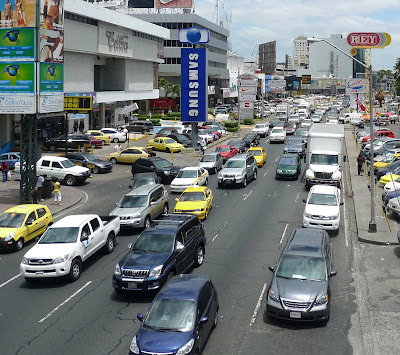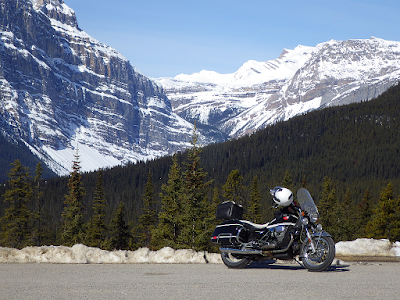The Driving Post
People have been asking me about driving in Latin America, and how dangerous it is. If you are reading this in Canada or the United States, I'll bet you saw more accidents in your morning commute than I have seen since I entered Mexico on February 5. But, if like me, your driving experience has been limited to Canada and the US, riding a moto here can be terrifying.
If you want to ride here you have to unlearn everything you thought you knew about how riding in traffic. If you have ever raced, the unwritten rules are sort of the same as on the race track, pass the slower guys anyway you can, but never recklessly, if you are slow, expect the fast guys to pass you anyway they can, you ride your bike, they ride theirs.
Most of the highways are two lanes or 4 lanes with a divider. You share the road with cars, trucks, other motos, mostly of the small variety, buses, dogs, donkeys, horses, pigs, goats, chickens, pedestrians, bicycles, moto taxis, just about everything that moves. You are not allowed to hit anything, and neither are they.
First off, speed limits, in most Latin American countries the posted speed limit is a suggestion to be taken as seriously as advice from your mother. The police have better things to do than chasing speeders, (unless you are in Costa Rica, Honduras or Panama).
The maximum posted speed everywhere I have been so far is 80 kmh, with the exception of a very few limited access toll roads where the speed limit was 110 kmh. You won't have many opportunities to go faster than about 120 for brief periods, you will be doing good to average 60 kmh overall. Speed is controlled by the conditions of the road, the other vehicles, roaming domesticated animals, speed bumps, tight curves, and the towns, which are only about 10 or 20 kilometers apart.
An octoganal red sign that says PARE (stop) is treated the same as a yield sign, drivers stop only if someone is coming.
Traffic circles are common in many Latin American countries.
Passing is permitted any way you can manage it without actually hitting anything, including but not limited to left, right, or up the middle. Be prepared to move over when facing an oncoming line of traffic backed up behind a slow moving vehicle.
The unwritten rules of the road are, slower yields to faster, smaller yields to bigger. If you are going slower than the guy behind you, move over, he is not going to hit you, there is room enough on a two line highway for three full size tractor trailers side by side.
Traffic is usually heavy close to towns, and gridlocked in the cities. Motos can and do thread through stopped traffic, between cars, in front of stopped cars, up the sidewalk, whatever works. Just don't hit anything.
Traffic lights are usually respected, but if it stays red too long, and it is safe to proceed, drivers will run the light. Sometimes the lights are not working. They generally place a convenient PARE sign in the intersection for those eventualities.
The cities and towns mostly pre date automobile traffic, and the streets are very narrow, so usually what happens when you enter a town is that the highway is split into opposing streets, each one way in opposite directions. Whenever this happens watch carefully for signs that lead you back out of town. If there are no signs, follow the big trucks, and hope they are going through.
Latin American drivers are accustomed to sharing the road with a wide variety of vehicles, and other moving objects. They see you, and they are not going to run you over unless you do something unexpected. Think of a squirrel or a deer on the road, nobody wants to hit them, the reason they become road kill is because they are unpredictable. If you panic and do something unpredictable from the local driver's standpoint, you are making it difficult for the other drivers to avoid hitting you.
The biggest adjustment I had to make was to my comfortable distance zone. Keep your one car length for every 10 kph or whatever from the guy in front of you, and the guy behind you will be in there before you can blink. If the big truck behind the other big truck wants to pass and you are going the other way, you better move over, it's OK, there is lots of room. If someone puts their bumper 6 inches off your license plate, either pick up your speed or move over. If a Latin American driver is going to pull something that would trigger a full blown road rage incident in Gringoland, he will toot his horn as a courtesy to let you know he is about to have your ass. If an oncoming driver flashes his lights or high beams he is warning you that you are approaching a hazard, be alert for anything from a donkey road kill to a sand dune in your lane.
You can go as fast or as slow as you prefer and road conditions allow. If you want to go slow, move over to the right, everybody will pass you, but they won't hit you, it's OK nobody gets upset, you are probably going faster than the man riding the horse. If you think you are ready for the big time go ahead and pass everybody. As far as solid yellow lines go, refer to the earlier paragraph on speed limits and stop signs. Don't hit anybody either.
Road hazards to watch for,
Trucks, the big highway hauler drivers are the most courteous and also the slowest vehicles on the road if you are in towns, near curves or in the mountains. They will do what they can to let you pass, and wave you on if the road is clear.
Buses, and there are lots of buses, are the worst. They will stop anywhere, including the middle of the road to unload or load passengers. They will also dart from one side to the other, or pull a big passing move on you and then throw on the brakes to let somebody off or on. If someone is standing beside the road, chances are they are waiting for a bus, in any case the bus will slow for them whether they want one or not.
Intercity taxis are also very good, if you follow one (not too close) you can learn how to drive in Latin America from an expert who drives all day every day. The taxis in the cities are like buses everywhere, stay clear.
(El Yellow Peril)
Farm trucks are the same as farm trucks everywhere, slow and oblivious. If you see a tiny pickup truck with stock racks and people sitting or standing on the truck bed you are actually seeing a rural bus. They are usually slow, and keep to the side. Moto taxis, three wheel cars, etc. are very slow.
The man in the shiny new luxury car truck or SUV is king of the road. He is not used to motos that can travel at high velocity, and will do whatever he needs to pass you. Best to let him go. He can be very persistent.
Other motos, scooters and mopeds are typically of the 200 cc or less variety, they will dart all around you in the cities, but on the highway a twist of the wrist leaves em behind.
You will also need to keep your eye out for cows, pigs, and other creatures. Dogs are the same as dogs everywhere, most of want to chase you, and quite a few do. Dogs are also the most common road kill I saw, probably a 10 to one ratio of dogs to all other species, so I guess it is OK to hit a dog.









Comments
Post a Comment